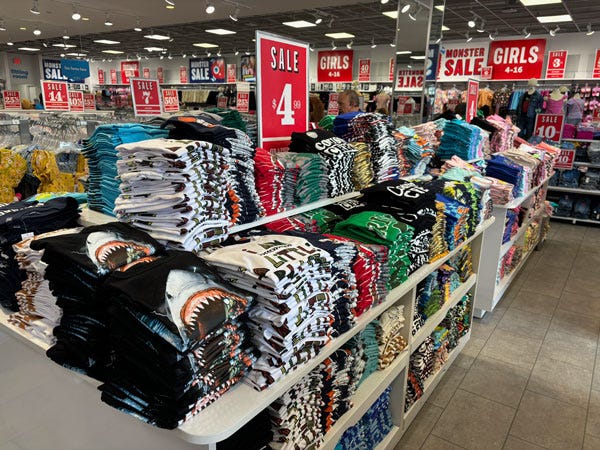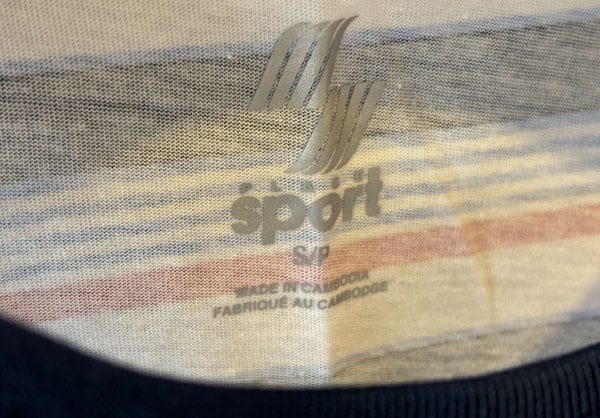Thrift Amongst Abundance
Questioning how best to buy clothes for my kids while avoiding exploitative systems
Welcome to another edition of Willoughby Hills!
This newsletter explores topics like history, culture, work, urbanism, transportation, travel, agriculture, self-sufficiency, and more.
The other day, we went to an outlet mall. Once upon a time, outlets were a secondary market for retailers to sell their overstock or items that may be slightly irregular and unable to command full price in a regular store. They were an efficient way to move merchandise that might otherwise have been discarded and they offered a bargain for the shopper.
Of course, if you’ve been in an outlet mall lately, that’s no longer the case. Some shops in outlets are indistinguishable from their mainline counterparts, while others are stocked with their own line of specialty product designed and made specifically for the outlet.
I’ve spent a lot of time over the last few years having conversations on the podcast and writing in this newsletter about the problems with the modern fashion industry. Amelia Pang described to me how the Uyghur people in China are often detained as political prisoners and forced to work in garment factories that create clothing for western brands. Francisca Gajardo told me about the massive clothing dumps in the Chilean desert where literal tons of western clothes wind up, sometimes unused with tags still attached.
As I’ve been learning about the destructive system of our overconsumption of fashion, I have done everything in my power to divest from this harmful system. I’ve chronicled my year of attempting to not buy any new clothes and talked about the joys of rediscovering old clothes in my closet.
This no new clothes challenge was a personal mission for me, but it was not something that I imposed on my kids. I have tried to share with them the information that I know about the problems with fashion, and we try to be conscious of only buying them what they need, but they still get new clothes from time to time.
On this recent trip to the outlet mall, they picked up a few things for back to school that were priced well and looked like they would last for a long time. Still, I couldn’t help but notice the waste of the fashion industry all around us.
In The Children’s Place, for example, clothing was piled on racks in such abundance that it was almost suffocating. The store was in the process of having a “Monster Sale,” where some items were advertised as low as $2.99. Nearly everything was made with at least some synthetic fibers (aka plastic) and much of it was made in Cambodia (which also has major ethical issues with its clothing manufacturing).
Our children are being taught from an early age to consume, consume, consume.
I don’t mean to just pick on The Children’s Place here. Nearly every children’s apparel seller, from Wal-Mart and Target to Gap and Old Navy, look similar to what I saw at the outlets. It’s piles and piles of overseas clothing, sold cheap, and likely turned over several times per year with new replacements.
And here’s my biggest problem with all of it: there’s not an easy alternative.
One of the unspoken parts of my No New Clothes challenge is that it worked, at least in part, because I had spent the prior 20 years overconsuming and could afford to coast on that abundance.
I had a nice, packable rain jacket, but it’s entirely synthetic and I purchased it at Uniqlo a few years ago. I wouldn’t buy the same one today brand new, but because I bought it before I knew better, I sort of give myself a free pass. It’s easy to shut off the tap for a while when you have plenty of reserves. But my kids don’t have that.
There are parts of my adult wardrobe that need replacing from time to time, and when it’s one item at a time, it’s easy to spend time doing homework and finding something better. I wrote a few weeks ago about buying new socks and happily finding some American made ones at Costco that were affordable.
The same goes for replacing say a pair of jeans. At this point in my life, I can wear the same jeans for several years at a time, and it makes sense to spend a little extra money to buy some that are made of better materials and using better labor practices (ideally made in America too).
That gets much harder when purchasing kids’ clothes. Their entire wardrobes need revamping every year or two as they grow: literally every single item gets outgrown at some point. And when it’s time to buy new, every retailer seems to be a riff on the same theme: cheap goods, cheap materials, likely made by cheap labor.
Buying used helps break some of this cycle, but not entirely. We shop at thrift stores with our kids, but their stock can be unreliable, especially when seeking a specific item. For example, we bought my son a pair of rain pants this week at the Columbia outlet because his school spends a lot of time outside. The likelihood of a thrift store having rain pants in his size, in good condition, and in a style that will appeal to him is pretty low. Even if we could find the perfect used rain pants, my kids still need things like socks and underwear that are probably safest to buy brand new.
It’s a reminder to me that so many of the systems in our modern society are meant to be ingrained like this. They’re designed to be difficult to untangle. Even for me, somebody who is aware of the problems with modern fast fashion and does all I can to avoid it for myself, at some point, I still have to be a part of that system for my family.
I wish I knew the alternative, but I don’t yet. If any of you do, I would love to hear how you approach this issue in your house. Is there a way to raise conscious kids outside of this system, or do we just need to accept that the system is here and sometimes we all just have to be a part of it? I’d love to hear from you in the comments.
Thanks for reading Willoughby Hills! Subscribe for free to receive new posts and support my work.
Related Reading
If you’ve missed past issues of this newsletter, they are available to read here.






